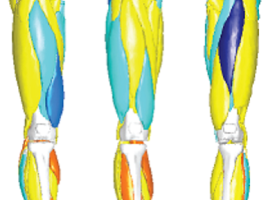Muscle Level Modeling

Modeling Facioscapulohumeral Dystrophy
Facioscapulohumeral dystrophy (FSHD) is the third most common form of muscular dystrophy which typically causes progressive muscle weakness via fat infiltration into muscle through a genetic mutation on the DUX4 gene. The progression of the disease is highly variable across muscles and patients; however, the mechanisms behind this variability are largely unknown. While some treatments are in the clinical trial phase, the wide variability across the population presents a major challenge for in vivo analysis and thus development of treatments and the associated design of clinical trials. This project aims to create a computational modeling framework for FSHD by leveraging finite element analysis (FEA) and agent-based modeling (ABM) to simulate the progression of fat infiltration on the mechanics of the micro-environment and consequent cellular behavior and inflammatory responses, ultimately providing a more scientific basis for developing and evaluating emerging therapies.
Modeling Pelvic Floor Dysfunction
This project involves the segmentation and modeling of the pelvic floor muscles in women to better understand pelvic floor dysfunction/injury. The goal is to develop a scientific basis for mitigating and treating pelvic floor dysfunction. In the future, we hope to leverage AI to characterize pelvic floor variation and develop a “pelvic floor simulator,” which will enable quick, efficient, and subject-specific modeling that can be implemented in a clinical setting to assess pelvic floor health and function and empower individualized treatment in the women’s health field.